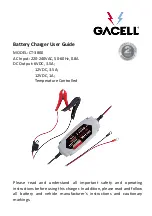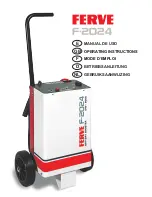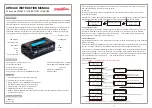
702-000164
Model:
OC-SW121009
(6V 1A/12V 900mA Charger) - Cat No.VM12991-11
IMPORTANT SAFETY INSTRUCTIONS: SAVE THESE INSTRUCTIONS
THIS MANUAL CONTAINS IMPORTANT SAFETY AND OPERATING INSTRUCTIONS FOR 12V/ 6V
BATTERY CHARGER, VM12991-11. KEEP IT WITH OR NEAR CHARGER AT ALL TIMES.
1.
WARNING -
RISK OF EXPLOSIVE GASES.
WORKING IN VICINITY OF A LEAD-ACID BATTERY
IS DANGEROUS. EXPLOSIVE GASES DEVELOP
DURING NORMAL BATTERY OPERATION. IT IS
IMPORTANT THAT EACH TIME BEFORE USING
YOUR CHARGER, YOU READ THIS MANUAL AND
FOLLOW THE INSTRUCTIONS EXACTLY.
1.1 To reduce risk of battery explosion, follow these
instructions and those published by battery
manufacturer and manufacturer of any equipment you
intend to use in vicinity of battery. Review cautionary
marking on these products and on engine.
1.2 Do not expose charger to rain, snow, or liquids.
1.3 Use of an attachment not recommended or sold by the
battery charger manufacturer may result in a risk of fire,
electric shock, or injury to persons.
1.4 To reduce risk of electric shock, unplug charger from
AC outlet before attempting any maintenance or
cleaning. Turning off controls will not reduce this risk.
1.5 An extension cord should not be used unless
absolutely necessary. Use of improper extension cord
could result in a risk of fire and electric shock. If
extension cord must be used, make sure that pins on
plug of extension cord are the same number, size and
shape as those of plug on charger and that the
extension cord is properly wired and in good electrical
condition and that the wire size is large enough for A.C.
ampere rating of charger as specified in the following
table:
RECOMMENDED MINIMUM AWG SIZE FOR
EXTENSION CORDS FOR BATTERY CHARGERS
Length of cord (feet): 25 50 100 150
AWG
size
of
cord: 18 18 18 18
1.6 If charger is equipped with an input power cord, do not
operate charger with damaged cord or plug - replace
the cord or plug immediately.
1.7 Do not operate charger if it has received a sharp blow,
been dropped, or otherwise damaged in any way; take
it to a qualified serviceman.
1.8 Do not disassemble charger; take it to a qualified
service center when service or repair is required.
Incorrect reassembly may result in a risk of electric
shock or fire.
1.9 The charger is not intended for use by young children
or infirm persons without supervision.
1.10 Young children should be supervised to ensure that
they do not play with the appliance.
2. PERSONAL
PRECAUTIONS
2.1 Someone should be within range of your voice or close
enough to come to your aid when you work near a
lead- acid battery. Have plenty of fresh water and soap
nearby in case battery acid contacts skin, clothing or
eyes. Wear complete eye and clothing protection. Avoid
touching eyes while working near battery.
2.2 If battery acid contacts skin or clothing, wash
immediately with soap and water. If acid enters eye,
immediately flush eye with running cold water for at
least 10 minutes and get medical attention immediately.
2.3 NEVER smoke or allow a spark or flame in vicinity of
battery or engine.
2.4 Be extra cautious to reduce risk of dropping a metal
tool onto battery. It might spark or short-circuit battery
or other electrical part that may cause explosion.
2.5 When working with a lead-acid battery, remove
personal metal items such as rings, bracelets,
necklaces, watches, etc. A lead-acid battery can
produce a short-circuit current high enough to weld a
ring or the like to metal, causing a severe burn.
2.6
Use charger for charging a Lead-Acid Battery only.
It is not intended to supply power to a low voltage
electrical system other than in a starter-motor
application. Do not use battery charger for charging
dry-cell batteries that are commonly used with home
appliances. These batteries may burst and cause injury
to persons and damage to property.
2.7
NEVER
charge a frozen battery.
2.8 The charger design for charging 18 Ah. Lead Acid
batteries maximum.
3.
PREPARING TO CHARGE
3.1 If necessary to remove battery from vehicle to charge,
always remove grounded terminal from battery first.
Make sure all accessories in the vehicle are off, so as
not to cause an arc. Be sure area around battery is well
ventilated while battery is being charged. Gas can be
forcefully blown away by using a piece of cardboard or
other non-metallic material as a fan.
3.2 Clean battery terminals. Be careful to keep corrosion
from coming into contact with eyes. Add distilled water
in each cell until battery acid reaches level specified by
battery manufacturer. This helps purge excessive gas
from cells. Do not overfill. For a battery without caps,
carefully follow manufacturer's recharging instructions.
3.3 Study all battery manufacturer's specific precautions
such as removing or not removing cell caps while
charging and recommended rates of charge.
3.4 Determine voltage of battery by contacting battery
manufacturer and make sure it matches output rating of
battery charger.
4. CHARGER
LOCATION
4.1 Locate charger as far away from battery as dc cables
permit.
4.2 Never place charger directly above battery being
charged; gases from battery will corrode and damage
charger.
4.3 Never allow battery acid to drip on charger when
reading gravity or filling battery.
4.4 Do not operate charger in a closed-in area or restrict
ventilation in any way.
4.5 Do not set a battery on top of charger.
5.
DC CONNECTION PRECAUTIONS
5.1 Connect and disconnect DC output terminals only after
removing charger from AC outlet.
5.2 Never allow DC output terminals to touch each other.
5.3 If problems arise connecting the output leads, solicit the
aid of your Dealer from whom you purchased this
product or the charger manufacturer for finding a
suitable connection device for your application.




















